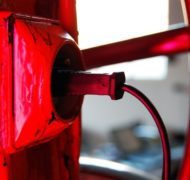Connecting to Customers
Blog / Produced by The High Calling
There was a time when I did most of my work as a claims adjuster by telephone. I knew some customers by voice, but most by a flat manila jacket with a seven-digit code scratched across the top edge.
With a hands-free headset comfortably in place, I could talk to one customer and email another at the same time. I sorted mail while I recited lesser known clauses of a contract to a disappointed policyholder. And when it came to it, I hit the mute button on the phone and muttered inaudible responses to a caller’s ignorance or indignation.
When everything that needed saying was done, I disconnected.
From the call. From the caller.
There was always another drawer lined with those manila uniforms waiting for my attention. Disconnecting wasn’t so much apathetic disregard for another’s plight as it was a skill perceived as necessary for emotional survival in a workday steeped in pain and anger and loss.
Today things don’t work quite the same.
I know my customers by face. I stand with them in their mess and look them in the eye. I don’t catalog their voices, but I know them. When we talk on the phone, I can tell when their throats catch or when they grow hoarse from too much time sorting in the soot.
Tainted water from their basement might be soaking into my socks. Or I might smell smoke late into the evening, pulled into my skin from my time amongst their ashes. It’s more difficult to disconnect when I’ve stood shoulder to shoulder with them, when they’ve held the other end of my tape measure, or even when I’ve caught a piece of them at the edge of the camera’s viewfinder.
But maybe, that disconnection isn’t so necessary. Perhaps I do better work because, in a way, the people come home with me.
A few days ago, I sat across the kitchen table with a couple a little older than my parents. Just nights before, they awoke to flames not far from their bedroom. Formalities out of the way, I set down my pen, turned off the tape recorder and, chin in my hand, just listened. She told the story of a house fire, but she also told a bigger story of their life—their hardships, their triumphs, their dreams. Hidden in her words was a another story altogether.
She eats fear with morning coffee
chunks of ash, black in her mouth
worries cinders
between delicate fingers
mixed with a trickle
from her cheek to spread
on burnt toast.
I can’t tell you their story, though I so want for you to know it. I can’t introduce you to these folks, but I so want you to know them. But I can let her story work its way inside me, and I can weave just a few words around to bear witness to a woman who knows fear and pain, joy and loss, and faces it with a sense that it’s as ordinary as breakfast.





